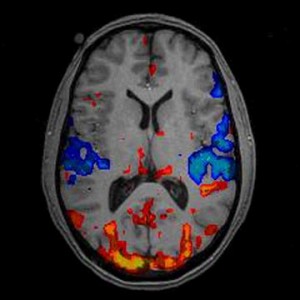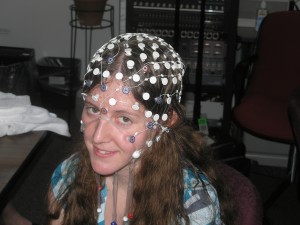Group 13: Data!
Quick recap: We’re investigating the science of “mind-reading.” Each of us selected a specific topic to research. Maddy is looking into how fMRI works. Adam is examining current research being done. I (Jackie) am going to talk about applications of all this technology.
Here’s what I’ve found so far:
Applications of mind-reading technology
- Applications of “mind-reading” technology
- Overview, previous approaches, limitations – deCharms (2008) discusses how real-time brain imaging (e.g., with fMRI) allows access to both subjective experience (to an extent) and to objective observations and quantitative measurements of brain activity. He outlines some past approaches to “mind-reading” as well as limitations to current approaches. This leads to a discussion of the applications of current neuroimaging research:
- Lie detection
- Langleben (2008) argues that blood oxygenation level-dependent (BOLD) fMRI could be sensitive to differences between lies and truth. The key, he claims, is that BOLD fMRI can only compare states rather than positively identify deception. He discusses how many popular science articles conflate how much fMRI can do.
- Mertens & Allen (2008) discuss whether ERP-based procedures could detect deception, instead of or in addition to fMRI.
- Moreno (2009) discuss ethical issues in lie detection and how the law should be influenced by cognitive neuroscience, specifically in cases where neuroimaging could be used to determine truth, lies, and guilt.
- Pain detection
- Marquand et al. (2010) suggest that supervised machine learning algorithms can be used to decode fMRI data. They use this kind of technique to show that fMRI can be used to predict participants’ subjective pain ratings and propose that it will be a useful method for producing qualitative predictions about brain states.
- Brain-computer interfaces
- Direct brain communication in paralysis, motor restoration in stroke – Birbaumer & Cohen (2007) evaluate the use of EEG and fMRI in brain-computer interfaces, focusing on applications for paralyzed patients and for motor restoration in the case of stroke. Although currently, our understanding of the information flow in the brain that is required for such interfaces to work is incomplete, such interfaces will eventually be able to be used for direct brain communication and will allow otherwise “locked-in” patients to interact with the world.
- Daly & Wolpaw (2008) also discuss advances in the analysis of brain signals and training patients to control those signals, focusing on EEG techniques specifically for patients with severe motor disabilities.
- Pattern analysis and future research
- Norman et al. (2006) argue that fMRI data can be used in conjunction with sophisticated pattern-classification algorithms to decode the exact information represented in a patient’s brain at a particular moment in time. They discuss factors that would boost the performance of this method — it is possibly the most promising research toward actual mind-reading.
- In the press: Where the reporters think this research is headed.
- Biever (2008) – to record and read people’s dreams
- Debrosse (2010) – as a counter-terrorism technique
- Masterman (2009) – in court, for lie-detection
- Graham-Rowe (2011) – brain-computer interfaces useful to the disabled
- BBC News (2005) – to read unconscious thoughts, attitudes, preferences
References (credible)
Birbaumer, N., & Cohen, L. (2007). Brain-computer interfaces: communication and restoration of movement in paralysis. Journal of Physiology, 579.3: 621-636.
Daly, J., & Wolpaw, J. (2008). Brain-computer interfaces in neurological rehabilitation. The Lancet Neurology, 7: 1032-43.
deCharms, C. (2008). Applications of real-time fMRI. Nature Reviews Neuroscience, 9: 720-729.
Langleben, D. (2008). Detection of deception with fMRI: Are we there yet? Legal and Criminological Psychology, 13: 1-9.
Marquand, A., Howard, M., Brammer, M., Chu, C., Coen, S., & Mourão-Miranda, J. (2010). Neuroimage, 49(3): 2178-2189.
Metens, R., & Allen, J. (2007). The role of psychophysiology in forensic assessments: Deception detection, ERPs, and virtual reality mock crime scenarios. Psychophysiology, 45 (2): 286-298.
Moreno, J. (2009). Future of neuroimaged lie detection and the law. Akron Law Review, 717-737.
Normon, K., Polyn, S., Detre, G., & Haxby, J. (2006). Beyond mind-reading: multi-voxel pattern analysis of fMRI data. Trends in Cognitive Sciences, 10(9): 424-430.
Popular science news
BBC News. (2005, April 25). Bran scan ‘sees hidden thoughts’. BBC News: Health. Retrieved April 19, 2011, from http://news.bbc.co.uk/2/hi/health/4472355.stm.
Biever, C. (2008, December 12). ‘Mind-reading’ software could record your dreams. NewScientist: Tech. Retrieved April 19, 2011, from http://www.newscientist.com/article/dn16267-mindreading-software-could-record-your-dreams.html.
Debrosse, J. (2010, March 15). Mind-reading technology being researched for foil terrorist attempts. McClatchy – Tribune Business News. Retrieved April 19, 2011, from ABI/INFORM Dateline. (Document ID: 1983690351).
Graham-Rowe, D. (2011, April 12). Dialing with your thoughts. Technology Review. Retrieved April 19, 2011, from http://www.technologyreview.com/communications/37357/?a=f.
Masterman, J. (2009, April 23). Current debates about fMRI research methods bear on policy questions. Science progress. Retrieved April 19, 2011, from http://www.scienceprogress.org/2009/04/fmri-mindreading-studies/.


